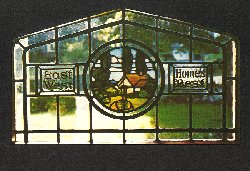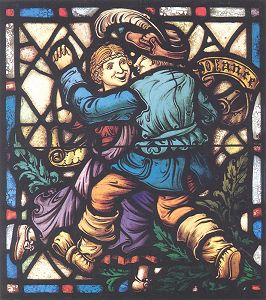|
Henry Keck |
||
Henry Keck was born in Geissen, Germany in 1873 and was introduced to a life of craftsmanship by his father who was a woodworker and cabinetmaker. When he was seven Keck became an apprentice in the stained glass workshops of Louis Comfort Tiffany (1848-1933), the celebrated interior designer of Art Nouveau fame who is especially known for his pioneering innovations in glass design. While Keck was learning the craft of glass cutting and glazing from Tiffany, he decided to go further and learn the art of stained glass design. He attended night classes in drawing at the Art Students League in New York City, and in 1895 returned to Germany for two years to study the art of glass design and glass painting at the Royal Academy School of Industrial Art in Munich. Upon his return to America Keck found jobs as a designer very scarce. He first went to work in a glass studio in Chicago and then returned to New York to become a designer and glass painter for Montague Castle Studios. In 1909 he joined the Pike Stained Glass Studio in Rochester, New York as a designer. A man with strong ideas about glass design, Keck became dissatisfied working for others and opened his own business in Syracuse in 1913, a city where no art glass studio then existed and where there was a burgeoning business in Arts and Crafts architecture, due in no small part to Ward Wellington Ward. It is likely that Keck already was acquainted with the architect Ward by this time, since Ward had commissioned glass from the Pike studio while Keck worked there. From 1913 on, Ward used only Keck's glass in his Syracuse Houses. Although Keck had many commissions from Ward and others for "house jobs," as he called the, they were only a small part of his total work. His main activity was the design and fabrication of church windows. Keck applied his skills sensitively however to the requirements of the Arts and Crafts house. The small landscapes he created -- most notably, the eighteen windows in Ward's house for Dr. Harry Webb -- are important examples of art glass in America. Keck's windows had a distinctive Arts and Crafts style, different from traditional stained glass. His drawing was simple and inventive. By thickly leaded outlines, he emphasized stylized but naturalistic figures, trees, and other details. His compositions were carefully studied and arranged in mosaic-like patterns. Keck chose opalescent glass for its bright and pure colors and unique textures which produced remarkable and dramatic moods in response to changing light. By 1920, when some 900 glass studios were operating in America, Keck had a reputation as one of the best stained glass designers in the business. This reputation was base mostly on the many Gothic revival church windows he produced throughout his lifetime. Even after his death in 1956, through the efforts of his lifetime associate, Stanley Worden, to whom Keck passed his knowledge of this exacting craft, the Henry Keck Stained Glass Studios continued to produce superior glass windows until it closed in 1974.
Click here to see additional Keck Studio windows
|


